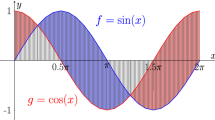Abstract
This paper presents a new methodology whereby the relationships among points of interest appearing in Internet Web pages may be graphically represented. This is done by quantifying the various points and representing them graphically using an intuitive interpretation of the similarity of sets. The similarity or interrelationships existing among various lines of research may be studied based on information taken from the Web pages using function taken from Learning Theory.
A visual analysis of those interrelationships has been applied to the field of machine learning during the time interval May 2003–May 2004.





Similar content being viewed by others
Notes
1This section follows from Skhölkopf (2000).
2The random variable X = has a Bernoulli(p) distribution with p = P(A).
3The transpose of a vector c is denoted by c′.
4The properties are demonstrated in González (2002).
5To interpret this graphic representation and the next it should be understood that the various items are arranged as a function of their respective probabilities.
6The order in which the items are represented goes fom left to right and from up to down.
References
Deus, J. (2001),Escalamiento Multidimensional, Cuadernos de Estadísticas, La Muralla. In Spanish.
González, L. (2000), Teoría del aprendizaje estadistico de la regresión. Máquinas de regresión de vector base (Theory of statistical learning in regression. Support vector machines regression), Investigative study, Dept. of Applied Economy I. University of Seville. In Spanish.
Gonzalez, L. (2002), Análisis discriminante utilizando máquinas nücleos de vectores soporte. Función núcleo similitud (Discriminative analysis using vector kernel machines support. The similitary kernel function), Doctoral thesis, University of Seville. In Spanish.
Grivel, C. L. (1995),A workstation to classify, chart and ana Une station de travail pour classer, cartographie et analyser l’information bibliographique dans une perspective de veille scientifique et technique, Solarion. In French.
Hair, J., Anderson, R., Tatham, R. & Black, W. (1998),Multivariante data analysis, fifth edn, Prentice Hall International.
Rosa, F., Gasca, R. & Ortega, J. (2001), ‘Metodología para el análisis visual de la evolutión de conceptos en base de datos textuales’,II Jornadas de Bibliotecas Digitales. In Spanish.
Ruiz-Baõos, R. & Contreras, F. (1998), ‘Como consultar eficazmente una base de datos bibliográfica. el método de las palabras asociadas’, http://www.ugr.es/fccortes/curriculum/toledo.html. In Spanish.
Skhölkopf, B. (2000), Statistical learning and kernel methods, Technical Report MSR-TR-2000-23, Microsoft Research Limited.
Skhölkopf, B. & Smola, A. J. (2002),Learning with Kernel, MIT Press.
Acknowledgements
This work has been partially funded by the Spanish Ministerio de Ciencia y Tecnología under grant DPI2003-07146-C02-01, the European Regional Development Fund (ERDF/FEDER), and ACPAI-2003/014 awarded by Junta de Andalucía (Spain).
The authors would like to thank the reviewers for their suggestions in improving the readability of the paper.
Author information
Authors and Affiliations
Rights and permissions
About this article
Cite this article
González, L., Velasco, F. & Gasca, R.M. A study of the similarities between topics. Computational Statistics 20, 465–479 (2005). https://doi.org/10.1007/BF02741309
Published:
Issue Date:
DOI: https://doi.org/10.1007/BF02741309




